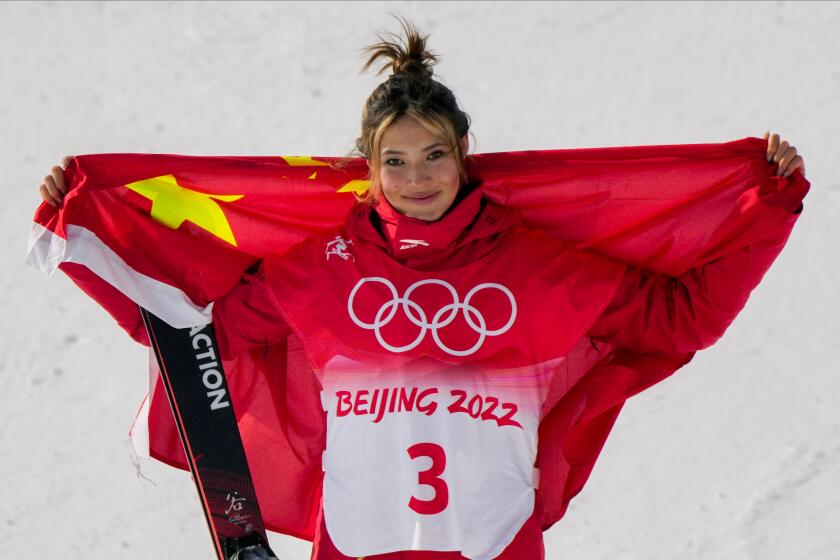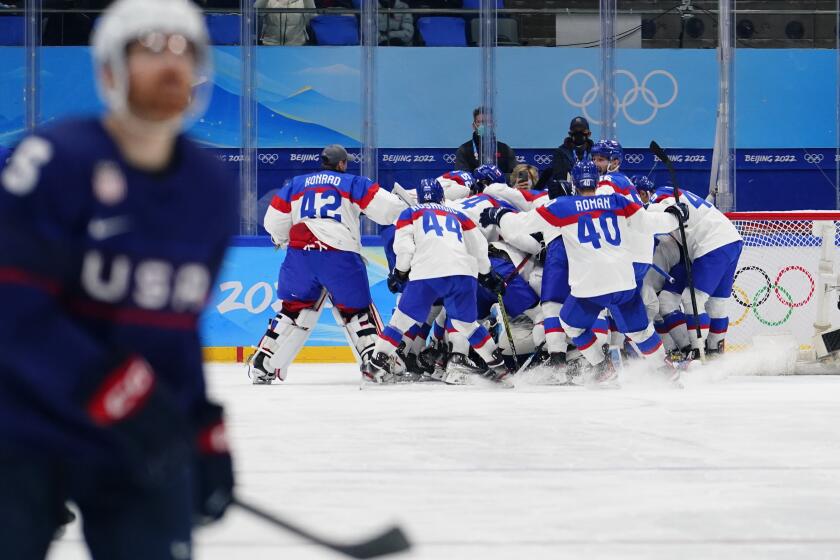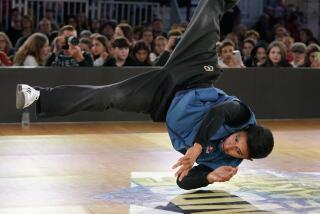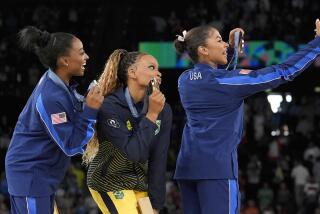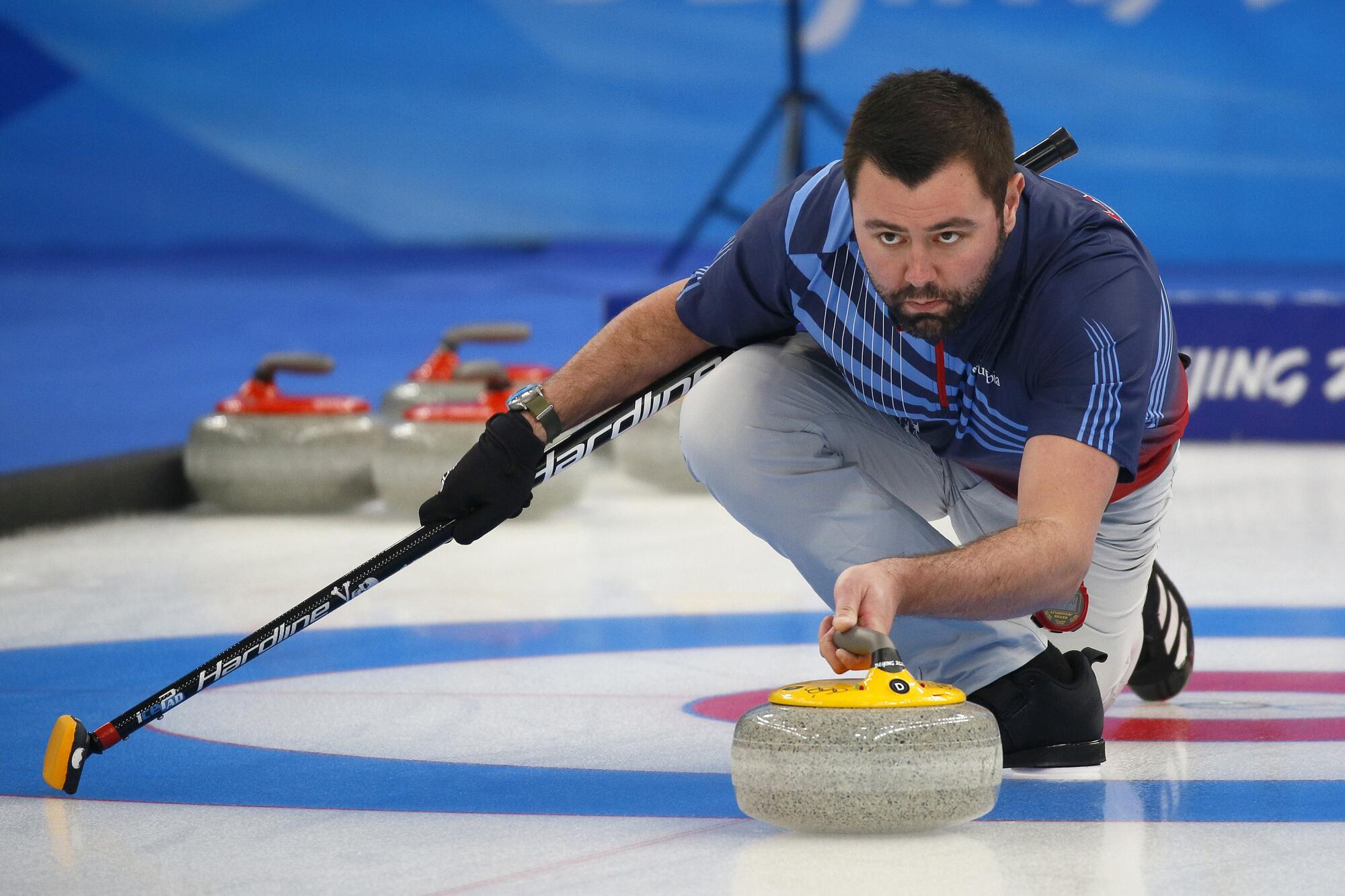
- Share via
BEIJING — The smooth, glistening ice on which curlers play — it is called a “sheet” — looks pristine, perfectly flat, to casual observers. Chris Plys sees something different as he crouches, squinting.
The U.S. Olympic team member knows slight deviations alter the surface. Devilish spots where his next shot might speed up or slow down. Places where the stone might curve left or fade right a little too much.
“It’s kind of like a golfer reading a green,” Plys says. “Every sheet is going to have its own little intricacies.”
Navigating those variations is actually tougher than reading a green because in curling they are invisible, discovered by trial and error during practice, committed to notebooks and memory.
As U.S. coach Sean Beighton puts it: “Curling is a little weird, right?”
Perhaps more than a little.
Every four years, when the Winter Games come around, this sport becomes a cult favorite among American television viewers. Maybe it appeals to fans because they can imagine sliding a polished rock across the ice in a way they could never picture themselves flying down a mountainside or executing a triple axel. Maybe curling is popular because it is easily understandable.
The team that lands the most shots closest to the center of the target is the winner.
Eileen Gu has become as good at avoiding answers to difficult questions as she is in freestyle skiing. She has one gold and one silver at the Beijing Olympics and one event to go.
Yet, beneath this simple façade, curling can be as strategic as chess with opponents trying to anticipate each other’s moves. Even more surprising, there is a highly technical element to the seemingly basic components.
Ice, rocks, those little brooms that players use to sweep like mad.
“Everything is super-sensitive depending on how hard you throw and how you throw,” says Vicky Persinger, who was Plys’ partner in mixed doubles. “You know there are certain paths on certain sheets where rocks may curl more or less. We really do have to think about a lot of things.”
———
The World Curling Federation uses only rocks from Ailsa Craig, a Scottish Island known for its quarries. Weighing 38 to 44 pounds, they are made of common green granite with an insert of blue hone granite that is better suited for sliding on ice.
The handles bolted on top contain heat sensors and lights that blink red if the thrower releases too late, past the “hog” line. When players tilt the stone up before throwing, they are activating the sensor.
Teams did not bring their own stones to the Beijing Games; officials provided two sets of eight for each sheet.
Each handcrafted stone has its own characteristics — slightly faster or slower, straighter or curvier. Stones also change over the course of a tournament, so teams get an hour of practice each night for “matching.”
The key is identifying the one tricky rock — sometimes two — in each set on a given sheet.
Teams might give the “cutter” to their best thrower. They might use it early, when shots are less critical, or save it for taking out an opponent’s stone because hard throws travel straighter.
“It just depends,” says Tabitha Peterson, skip of the U.S. women’s team. “There are different strategies.”
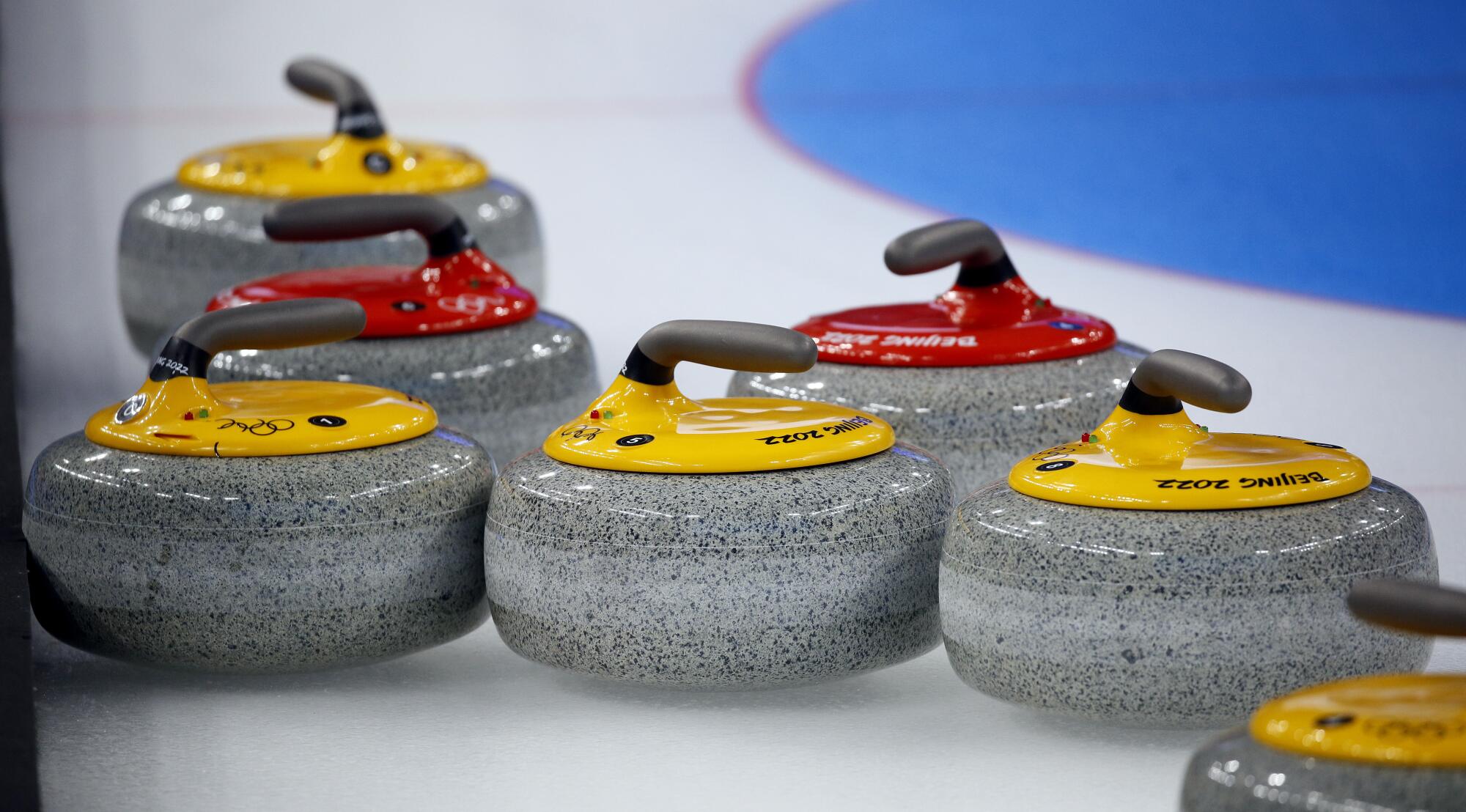
During practice, coach Beighton watches throws and scribbles in a red folder. The rocks are numbered one through eight, so he makes note of their speed and any potentially troublesome nuances.
When other teams play, Beighton peers through binoculars to scout how they are matching.
“They’re always mixing the stones around and we use all that data to figure out why they’re mixing around,” he says. “That kind of [influences] how we match.”
———
Each day, specialists walk the 150-foot-long sheets at the “Ice Cube” arena, water tanks strapped to their backs, a handheld wand sprinkling droplets that freeze on contact to the chilled surface. This “pebble” provides the best texture for curling.
Though the Olympics hire veteran icemakers from around the world, no two sheets can be made exactly alike.
Outside humidity can render the ice slower or faster. Sheets closest to the stands might act differently because of body heat from spectators.
The building itself has an effect because ice is only as uniform as the floor beneath it. Icemakers initially struggled with the sheets in Beijing as they repurposed the old Water Cube swimming venue from the 2008 Summer Olympics.
But curlers are accustomed to adapting.
“Sometimes the sheets are sloped to the wall or away from the wall or there’s a little dip or high edges,” Peterson says. “You can’t actually see that, visually, but you’re trying to get a map of what the sheet is doing.”
During practice, Beighton sets laser “speed traps” just past the hog line, the data relayed instantly to his cellphone. Players click stopwatches hanging from their waists, calling out the time it takes for a throw to reach the target, or “house.”
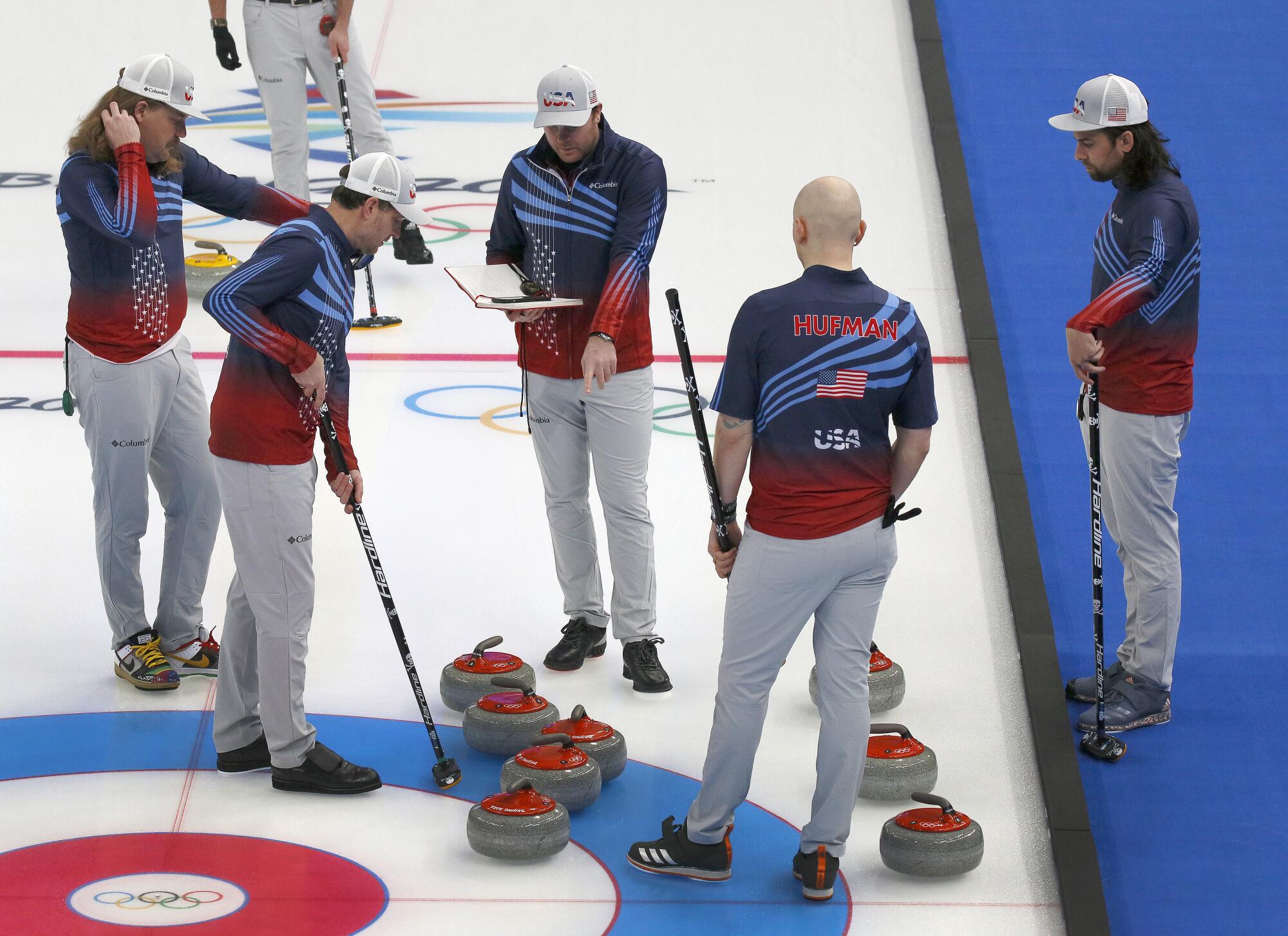
As teams get a feel for the speed of the ice, they watch for abnormalities. Men’s skip John Shuster noticed something as he attempted to curve a shot toward the button — the center of the target — from one side.
“I thought it was slightly tight,” he called to his teammates, “so I gave it a little out.”
Translation: His stone was missing the mark, so he put a little more spin on the handle.
In the quiet of evening, after competition has ended, the venue echoes with a scudding sound of practice throws and the heavy thunk of takeouts. The team’s alternate player often does the matching while starters rest. Joe Polo handled this duty when Shuster’s team won gold at the 2018 Pyeongchang Games.
“Joe didn’t throw a single stone during a game, but he threw almost as much as us because he was charting rocks at practice,” Shuster says. “Honestly, that’s part of the process.”
———
Of all curling’s technical elements, it seems odd that those funny little brushes nearly upended the sport. To understand “Broomgate,” start with some physics.
A stone builds up friction as it glides, which makes it slow down and curve more. Sweepers counteract this dynamic by brushing hard enough to generate heat, momentarily softening the ice pebbles in its path. So, as a shot heads down ice, the skip can try to control its path by calling for more or less brushing.
Curling’s big trouble arose in 2015 with the icePad, a broom head that claimed to focus energy at the very top of the pebbles. As sweeping became more effective, shots found their mark more often. Too often.
Before games, when opposing teams exchanged brooms for the purpose of inspection, things got ugly.
“There was a lot of name-calling and accusations,” Olympic champion Brad Gushue of Canada told the TSN network. “There was some stuff said among some guys that you’re probably not going to forget it.”
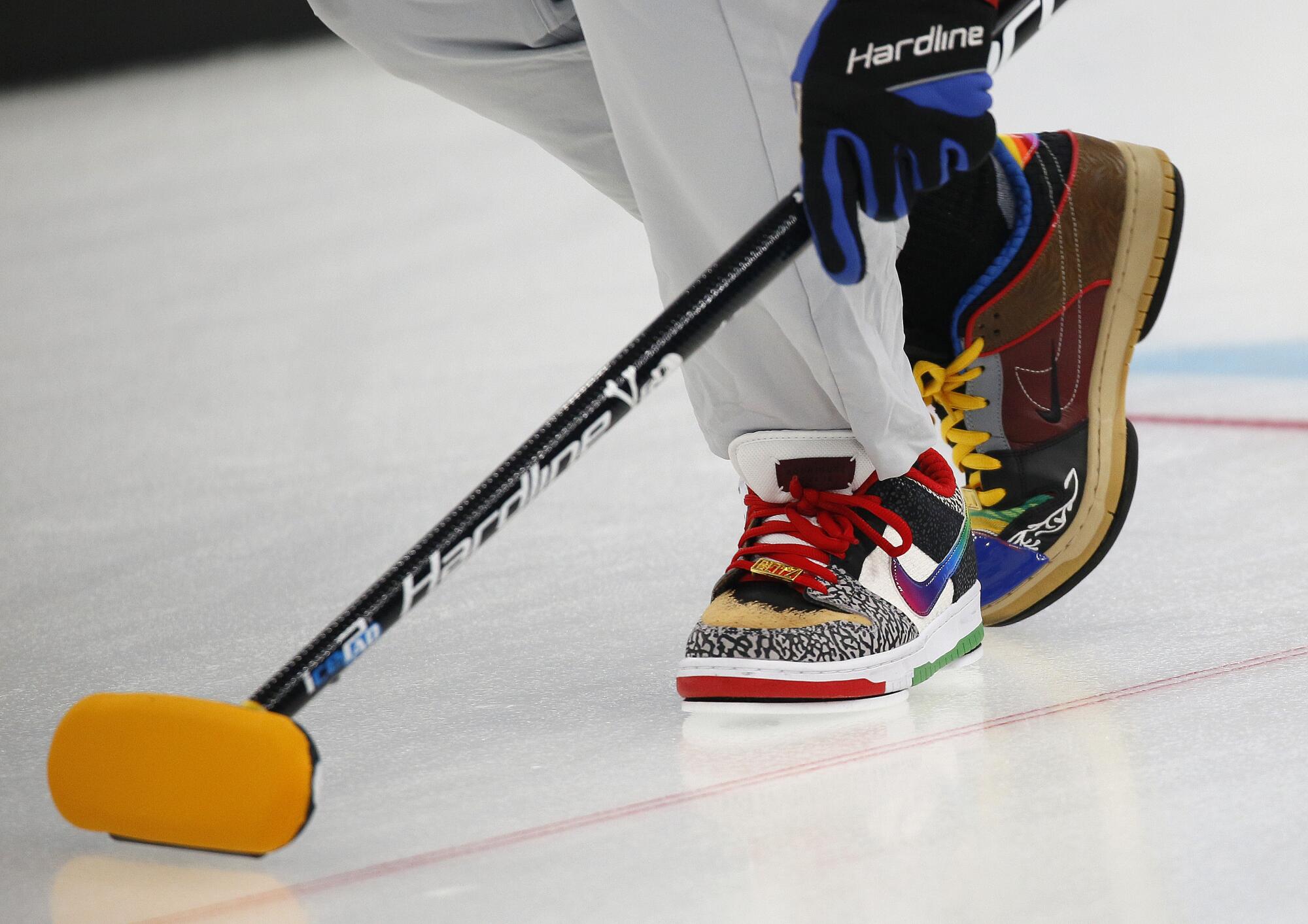
The curling federation soon convened a “Sweeping Summit” with lasers, robotic throwers and scientists from the National Research Council of Canada.
It was decided that brooms should be standardized, much like the official rocks. And like shoes — everyone wears a rubbery gripper on one foot and a slider, with Teflon or stainless steel, on the other. Officials settled on broom heads made of less-effective, synthetic fabric.
Now, when curlers talk about sweeping, they stick to the when and how hard.
“That was the goal, to have the broom be something that was important but didn’t dictate the outcome,” Shuster says. “We don’t have to think about it anymore.”
———
There are no warmups before Olympic curling games. Also no guarantees that the ice and rocks will behave as they did the night before.
Players must adapt on the fly. All that careful attention to equipment, the practice throws and pregame notes, mean nothing if they don’t communicate on the ice.
Coaches yell to their teams when it comes time to throw a cutter. Players relay the message among themselves because the sweepers and the skip showing where to aim at the far end must adjust.
“The one throwing it will remind them, remember this rock? Or they’ll have a little hand signal,” coach Laine Peters says. “You can’t make a shot by yourself. Everyone needs to have all the information.”
U.S. loses in quarterfinal shootout to Slovakia. Failure to take advantage of five-on-three advantage in third period may have been their undoing.
The Americans seemed bewildered by the Beijing venue during mixed doubles, finishing eighth out of 10 teams. Plys says: “Obviously we weren’t the fastest people to catch on to the ice.”
Things didn’t go much better for the men’s and women’s teams. The men lost in the bronze-medal game and the women didn’t make it out of round-robin play.
Curlers say winning and losing are determined by throwing the right shots at the right moments. But simple ice, rocks and brooms have a lot to do with that.
Shuster acknowledged the challenges of his sport after a round-robin loss to Italy.
“All of us were struggling to feel the draw weight,” he said, referring to the speed of the ice and the force of their throws. “We had a bunch of chances early and we just kept on missing … and that can happen.”
It can be a deceptively tricky game. Like pro golfers, even the world’s best curlers sometimes struggle to read the shot.
More to Read
Go beyond the scoreboard
Get the latest on L.A.'s teams in the daily Sports Report newsletter.
You may occasionally receive promotional content from the Los Angeles Times.

